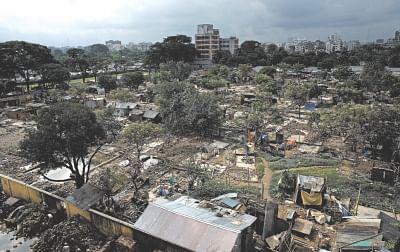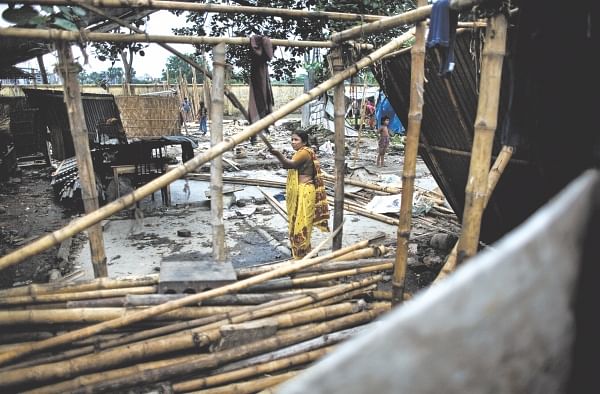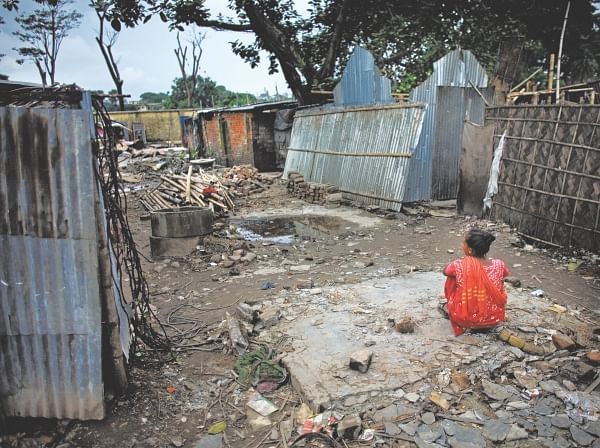| Home - Back Issues - The Team - Contact Us |
 |
| Volume 11 |Issue 08| February 24, 2012 | |
|
|
Perspective Parallel Lives Slum dwellers in Karail and other shanties are facing eviction Probir Kumar Sarker Tenants of Karail Slum were watching a demolition drive in the nearby shanty along the bridge at Banani 11. In that slum, which was at the west bank of the Gulshan Lake, families had finished packing their belongings and were moving from the small piece of land they had been living for the last 10 years. By evening, most of the 60 families left the place in the presence of Rajuk and police officials. They left, without uttering a word or waging any protest, as no words of hope came from the authorities over their future destination.
Rajuk held another drive in this slum on September 20 last year following a short notice conveyed through local security guards. At that time, the police and some local hooligans forced some 120 families out of the slum. But from the next day, some of these poor people started to build their makeshift homes again with polythene and bamboo. Fortunately, for them, neither Rajuk officials nor police came to vacate the place in the next four months. This time, says Matiar Rahman, who works as a security guard at an apartment opposite to the slum where he lived, they did not protest the eviction as it was launched following a High Court order to demolish the illegally set up structures on the lake. “We have to find a new place though it would be a pressure on our limited and small income,” he says. Parallel to this eviction drive, the people living in Karail's lakeside shanties started to remove the structures. The police have also warned them of a possible “eviction drive” within days if the “illegal structures” are not demolished. According to the High Court's recent order to free the lake from illegal encroachers, parts of Karail Slum that fall on the water must be removed. Most of the structures on the water were removed by the dwellers themselves before the law enforcers had come a week later and demolished around 60 shanties. The High Court order came in the middle of January following a news report according to which stated that illegal land grabbers had occupied part of the Gulshan Lake's west side afresh and built shanties there. But Mannan says that they have heard that Rajuk intends to demolish the whole slum, within the 60-day stipulated by the court, in cooperation with the owners of the land, which include government institutions as diverse as Bangladesh Telecommunications Company Limited, Public Works Department (PWD) and Ministry of Information and Communication Technology. Panic has swallowed up the slum dwellers. They want to know whether it is true. To make matters worse, they have heard Rajuk officials say that after vacating the area, they will set up park and walkways for the residents of the city's posh area.
Meanwhile, the PWD gave an eviction order to the Karail slum dwellers back in 2008 and was stayed by the High Court following a writ petition by rights and legal aid body Ain o Salish Kendra (ASK). On several occasions, the High Court has mentioned that the government should ensure rehabilitation of the slum dwellers before evicting them from a place in Dhaka and elsewhere. The High Court in January also directed the government to demarcate the lake as per Revisional Survey (RS) records and remove the illegal structures from it in the next two months. The authorities concerned were also asked to declare the lake an environmentally critical area. But neither any government agency nor the court this time has said anything about 'rehabilitation' of the people staying on the abandoned government land. “We want to live peacefully but will be united if you are thinking of evicting us from here. Give us a 5-acre land to build cheap apartments; we will certainly shift from here. We do not want to live in a slum and pollute the lake,” Mannan says. “We are ready to pay the government for the land we are using– water, electricity and gas bills. Now only a few houses have illegal water and gas connections while the power supplied in the slum is illegal too, thanks to some dishonest staff of the government bodies,” he adds. Around 1, 25,000 people live in 16,000 shanties across the city, which were built 32 years ago on 90 acres of government land. In the recent years, some shanties were set up along the water on its three sides by some influential people. These highly crowded areas are surrounded by water on three sides and there are five other small slums on the other side. The slum dwellers have already accepted it or taken for granted that they might not get something better in a 80 square feet hut at a cost of around Tk 800-Tk 1,500. They accept because they are too poor to afford a better place. But they have to live in the city for work since their income is higher here than their village homes. In most cases, they were found to be landless, affected by river erosions, floods, natural disasters and severe unemployment.
The instances of evicting 'illegal' occupants from unauthorised lands show that in most cases the residents, not the land grabbers, were targeted by the Rajuk and the other government agencies concerned, and were penalised. And none of them were ensured housing facilities from the government or anybody else. Locals say there are a number of illegal structures erected along the entire lake. Over the past years, many influential people have grabbed much of the lake at its different parts resulting in its present sorry state. The authorities, due to legal tangles could hardly recover a piece of these lands, where buildings have already been constructed. It, however, was successful in freeing some land by removing structures including small shops, and rickshaw and car garages. The map of the lake has also been changed over the years to accommodate the illegal plots. The previous caretaker government in 2007 formed an eight-member committee headed by Prof Nazrul Islam,to look into the issue of slum dwellers. Upon its recommendations, the then government pledged a 5-acre land for rehabilitating the evicted tenants in low-cost apartment buildings in Mirpur's Kalshi area. The recommendation is yet to materialise. In 2007 alone, at least 29 slums were knocked down. Meanwhile, another housing project for these poor people was launched in Bhashantek area. But allegations are there that the genuine slum inhabitants were not rehabilitated there. Different social organisations both international and local have been working in the slums of Dhaka and elsewhere in the country to better their livelihood, with special assistance in education, health, sanitation, credit facilities, and social and legal issues. According to a survey in Karail Slum by Dushtha Shasthya Kendra (DSK), more than 30 percent of the dwellers are day labourers, 20 percent rickshaw- and van-pullers, 18 percent garments workers, 12 percent small traders, around five percent drivers and others doing jobs as housemaids and small-wage labours. Of them, over 80 percent families earn only Tk 2,500-Tk 4,500 a month. Following the warnings by authorities on February 6, several schools and madrasas, shops and others structures set up on the danger mark of the lake have started to shift from the place. Officials of the schools, two shopkeepers and others are consulting the issue with Mannan, who himself is in a mess due to his heavy responsibility to save the people from eviction. They want to know what they should do in these circumstances. Members of different social, healthcare, sanitation and other service and training provider non-governmental organisations have also gathered at the west bank of the lake to see the eviction drive in Banani Bridge slum. From the first day, many of around 300 families in Karail Slum have started to look for a new place to live at an affordable cost – a major problem in the slums. It's true that they dump all wastes on the lakeside, polluting the water. The city corporation authorities do not carry garbage from the adjacent five other slums of the Karail. Drains and sewerage pipes are carrying waste from Gulshan, Banani and Dhaka Cantonment into the lake everyday. The authorities should think twice before taking any such demolition drive. People who live in the slums are the powerhouse of the city's economy. You can neglect them only at your own peril. Copyright (R) thedailystar.net 2012 |
||||


